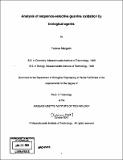| dc.contributor.advisor | Peter C. Dedon. | en_US |
| dc.contributor.author | Margolin, Yelena, 1977- | en_US |
| dc.contributor.other | Massachusetts Institute of Technology. Biological Engineering Division. | en_US |
| dc.date.accessioned | 2008-09-03T15:29:53Z | |
| dc.date.available | 2008-09-03T15:29:53Z | |
| dc.date.copyright | 2007 | en_US |
| dc.date.issued | 2008 | en_US |
| dc.identifier.uri | http://hdl.handle.net/1721.1/42381 | |
| dc.description | Thesis (Ph. D.)--Massachusetts Institute of Technology, Biological Engineering Division, February 2008. | en_US |
| dc.description | Vita. | en_US |
| dc.description | Includes bibliographical references. | en_US |
| dc.description.abstract | Oxidatively damaged DNA has been strongly associated with cancer, chronic degenerative diseases and aging. Guanine is the most frequently oxidized base in the DNA, and generation of a guanine radical cation (G'") as an intermediate in the oxidation reaction leads to migration of a resulting cationic hole through the DNA n-stack until it is trapped at the lowest-energy sites. These sites reside at runs of guanines, such as 5'-GG-3' sequences, and are characterized by the lowest sequence-specific ionization potentials (IPs). The charge transfer mechanism suggests that hotspots of oxidative DNA damage induced by electron transfer reagents can be predicted based on the primary DNA sequence. However, preliminary data indicated that nitrosoperoxycarbonate (ONOOCO2"), a mediator of chronic inflammation and a one-electron oxidant, displayed unusual guanine oxidation properties that were the focus of present work. As a first step in our study, we determined relative levels of guanine oxidation, induced by ONOOCO2 in all possible three-base sequence contexts (XGY) within double-stranded oligonucleotides. These levels were compared to the relative oxidation induced within the same guanines by photoactivated riboflavin, a one-electron reagent. We found that, in agreement with previous studies, photoactivated riboflavin was selective for guanines of lowest IPs located within 5'-GG-3' sequences. In contrast, ONOOCO2" preferentially reacted with guanines located within 5'-GC-3' sequences characterized by the highest IPs. This demonstrated that that sequence-specific IP was not a determinant of guanine reactivity with ONOOCO2". Sequence selectivities for both reagents were double-strand specific. Selectivity of ONOOCO2 for 5'-GC-3' sites was also observed in human genomic DNA after ligation-mediated PCR analysis. | en_US |
| dc.description.abstract | (cont.) Relative yields of different guanine lesions produced by both ONOOCO2" and riboflavin varied 4- to 5-fold across all sequence contexts. To assess the role of solvent exposure in mediating guanine oxidation by ONOOCO2", relative reactivities of mismatched guanines with ONOOCO2" were measured. The majority of the mismatches displayed an increased reactivity with ONOOCO2 as compared to the fully matched G-C base-pairs. The extent of reactivity enhancement was sequence context-dependent, and the greatest levels of enhancement were observed for the conformationally flexible guanine- guanine (G-G) mismatches and for guanines located across from a synthetic abasic site. To test the hypothesis that the negative charge of an oxidant influences its reactivity with guanines in DNA, sequence-selective guanine oxidation by a negatively charged reagent, Fe+2-EDTA, was assessed and compared to guanine oxidation produced by a neutral oxidant, y-radiation. Because both of these agents cause high levels of deoxyribose oxidation, a general method to quantify sequence-specific nucleobase oxidation in the presence of direct strand breaks was developed. This method exploited activity of exonuclease III (Exo III), a 3' to 5' exonuclease, and utilized phosphorothioate-modified synthetic oligonucleotides that were resistant to Exo III activity. This method was employed to determine sequence-selective guanine oxidation by Fe+2-EDTA complex and y-radiation and to show that both agents produced identical guanine oxidation pattems and were equally reactive with all guanines, irrespective of their sequence-specific IPs or sequence context. | en_US |
| dc.description.abstract | (cont.) This showed that negative charge was not a determinant of Fe+2-EDTA-mediated guanine oxidation. Finally, the role of oxidant binding on nucleobase damage was assessed by studying sequence-selective oxidation produced by DNA-bound Fe+2 ions in the presence of H202. We found that the major oxidation targets were thymines located within 5'-TGG-3' motifs, demonstrating that while guanines were a required element for coordination of Fe+2 to DNA, they were not oxidized. Our results suggest that factors other than sequence-specific IPs can act as major determinants of sequence-selective guanine oxidation, and that current models of guanine oxidation and charge transfer in DNA cannot be used to adequately predict the location and identity of mutagenic lesions in the genome. | en_US |
| dc.description.statementofresponsibility | by Yelena Margolin. | en_US |
| dc.format.extent | 155 p. | en_US |
| dc.language.iso | eng | en_US |
| dc.publisher | Massachusetts Institute of Technology | en_US |
| dc.rights | MIT theses are protected by copyright. They may be viewed, downloaded, or printed from this source but further reproduction or distribution in any format is prohibited without written permission. | en_US |
| dc.rights.uri | http://dspace.mit.edu/handle/1721.1/7582 | en_US |
| dc.subject | Biological Engineering Division. | en_US |
| dc.title | Analysis of sequence-selective guanine oxidation by biological agents | en_US |
| dc.type | Thesis | en_US |
| dc.description.degree | Ph.D. | en_US |
| dc.contributor.department | Massachusetts Institute of Technology. Department of Biological Engineering | |
| dc.identifier.oclc | 234441175 | en_US |
